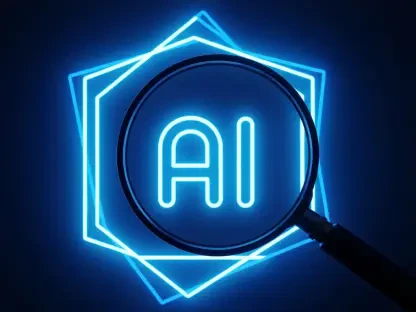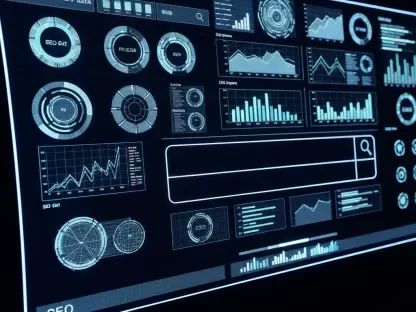Imagine a marketing team drowning in a sea of 91 different cloud services, each handling a fragment of their daily tasks, while 51% of employees spend over two hours on repetitive activities that drain creativity and time. This chaotic reality is the norm for many enterprises today, where fragmented tools and manual processes hinder efficiency. The rise of AI-powered task automation offers a lifeline, promising to connect disjointed systems into seamless workflows. This market analysis delves into the transformative impact of integrated automation on enterprise operations, examining current trends, data-driven insights, and future projections. The focus is on how this technology reshapes marketing technology (martech) stacks, boosts productivity, and addresses scalability challenges, providing a roadmap for businesses aiming to stay competitive.
Market Dynamics: The Growing Demand for Integrated Automation
The enterprise landscape is witnessing a seismic shift as businesses grapple with sprawling martech ecosystems. Research indicates that companies juggle an average of 91 marketing cloud services, leading to inefficiencies and overwhelmed teams. Only 1% of industry leaders consider their organizations mature in deploying AI across workflows, highlighting a vast untapped potential. Integrated task automation, which links disparate tasks into cohesive sequences, is emerging as a critical solution. Unlike isolated tools that automate single functions, this approach connects platforms like CRMs, email systems, and analytics dashboards, creating unified processes. The demand for such systems is driven by the need to eliminate manual bottlenecks and reduce the 10-15% of executive time spent on mundane tasks, as noted in recent studies.
This growing interest is also fueled by economic pressures to optimize resources. Enterprises are increasingly aware that fragmented tools not only waste time but also inflate costs with multiple subscriptions. A single integrated automation platform, often priced at a consolidated annual fee of around $5,000, contrasts sharply with the cumulative $250 monthly fees for standalone services. As a result, the market for AI-driven workflow solutions is expanding rapidly, with adoption rates climbing. Tools like Gumloop and Tray.ai are gaining traction for their ability to automate complex tasks such as SEO, social media scheduling, and lead routing without requiring extensive developer input, signaling a broader trend toward user-friendly, no-code solutions.
The competitive landscape further underscores this shift. With 75% of non-AI users planning to adopt automation within the next year, per recent surveys, businesses are racing to integrate these technologies to avoid falling behind. This urgency is compounded by the complexity of managing cross-functional teams—some campaigns involve over 200 staff across departments—where miscommunication risks are high. Integrated automation addresses these pain points by enhancing visibility and streamlining operations, positioning it as a cornerstone of modern enterprise strategy. The market is thus poised for significant growth as more organizations recognize the value of connected workflows.
Current Trends: How AI Automation Shapes Martech Stacks
One prominent trend in the martech space is the move from siloed automation to integrated systems. Historically, automation focused on standalone tasks, such as scheduling emails within a single platform, without syncing data to other tools like CRMs. Today, the emphasis is on creating seamless workflows where lead capture, data cleaning, segmentation, and email triggers operate in a connected sequence. Platforms like Zapier Enterprise and Workato, which integrate thousands of apps, exemplify this trend by enabling cross-platform data flow. This shift reduces manual data transfers, minimizes errors, and provides unified insights, allowing teams to make faster, data-driven decisions.
Another key development is the rise of low-code and no-code automation tools, democratizing access to technology. These platforms empower non-technical marketing teams to build custom workflows without relying on IT departments, addressing the backlog of tasks like website updates or user profile setups. For instance, Gumloop’s no-code interface allows marketers to automate SEO and social media tasks through a visual builder, enhancing agility. This trend aligns with findings that 48% of employees would embrace AI tools with proper training, indicating a market preference for accessible solutions that accelerate adoption and execution of campaigns.
Security and governance are also shaping the automation market as enterprises scale. With cybersecurity breaches affecting 46% of smaller businesses, robust features like role-based access control, audit logs, and encryption are becoming non-negotiable. Tools such as Tray.ai offer log-streaming and workspace partitioning to ensure data integrity across regions and teams. Additionally, regulatory pressures around data privacy are pushing vendors to prioritize compliance in their offerings. As automation scales, the ability to track failures and maintain transparency through KPIs—such as email bounce rates or CRM sync errors—becomes critical, reflecting a maturing market focused on sustainable growth.
Future Projections: The Next Frontier of Workflow Automation
Looking ahead, the market for AI-powered task automation is expected to evolve with greater sophistication between 2025 and 2027. Analysts predict a surge in hyper-personalized workflows, where AI not only automates operational tasks but also delivers predictive insights for campaign optimization. This could mean systems that anticipate customer behavior and adjust email sequences or content strategies in real time. The integration of machine learning into platforms like Make suggests a future where automation tools learn from past data to refine processes autonomously, reducing human oversight while maintaining accuracy.
Economic and regulatory factors will further influence market trajectories. As businesses face tighter budgets, the cost efficiency of integrated systems—consolidating multiple tool costs into a single subscription—will drive adoption. Simultaneously, stricter data privacy laws will necessitate automation solutions with built-in compliance features, such as sensitive data masking and just-in-time provisioning. Vendors are likely to respond by embedding these capabilities into their platforms, ensuring enterprises can scale without risking breaches or legal penalties. The market will thus see a convergence of efficiency and security as defining characteristics of leading tools.
The competitive edge of early adopters will also shape future dynamics. With adoption rates accelerating, companies that integrate automation now are projected to gain significant advantages in productivity and innovation over laggards. Emerging use cases, such as multi-system trigger workflows and cross-platform reporting, will become standard, enabling teams to orchestrate campaigns from ideation to launch with minimal friction. As tools continue to connect marketing, sales, and product departments through automated sequences, the enterprise workflow market will redefine operational benchmarks, setting a new standard for efficiency by the end of this forecast period.
Strategic Reflections and Actionable Pathways
Reflecting on the insights gathered, it is evident that AI-powered task automation has already begun transforming enterprise workflows by bridging fragmented martech stacks and slashing manual effort. The market analysis revealed a clear trajectory of growth, driven by trends like no-code platforms and heightened security demands, with projections pointing to even deeper personalization and predictive capabilities. These findings underscore the urgency for businesses to adapt swiftly to maintain a competitive stance.
Looking back, the implications for enterprises are profound, as automation offers not just efficiency but also scalability across complex operations. A strategic next step involves mapping high-friction tasks—such as audience segmentation or data hygiene—and piloting integrated tools like Tray.ai or Workato to address them. Establishing governance through clear ownership and metrics like email delivery success rates ensures sustainable implementation. By fostering cross-team collaboration and building feedback loops, companies can refine their approaches, turning automation into a catalyst for long-term innovation and growth.









